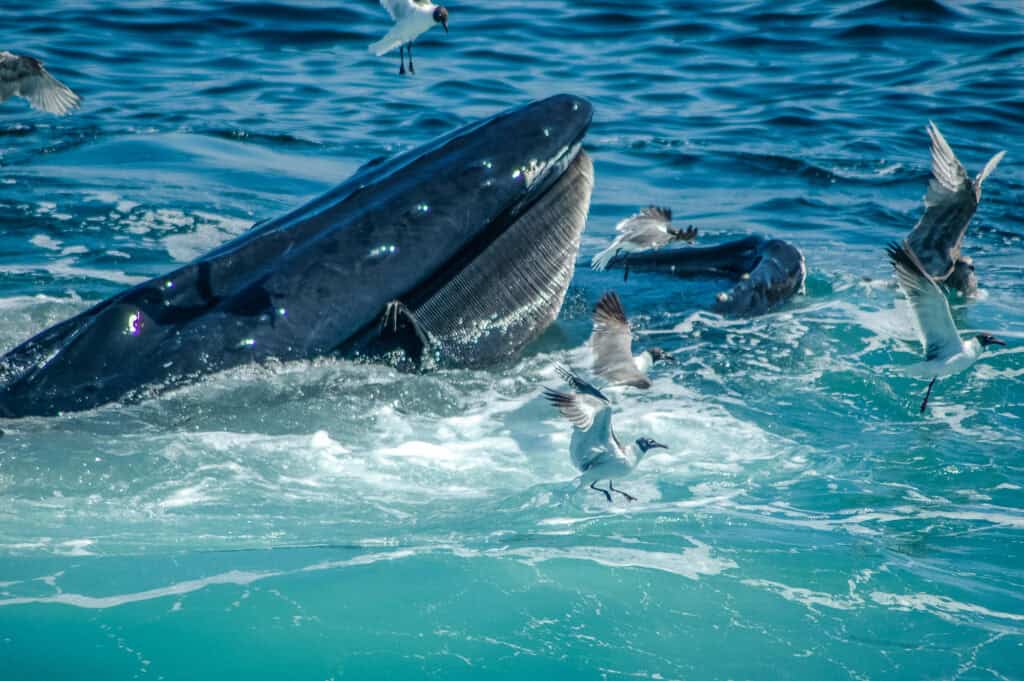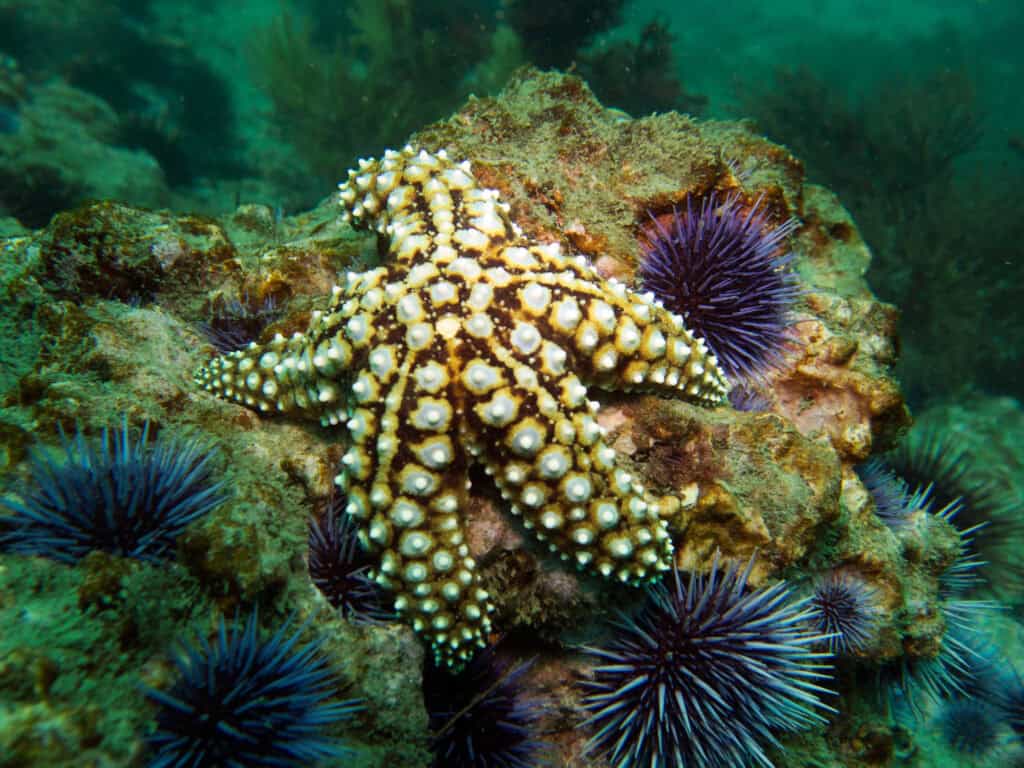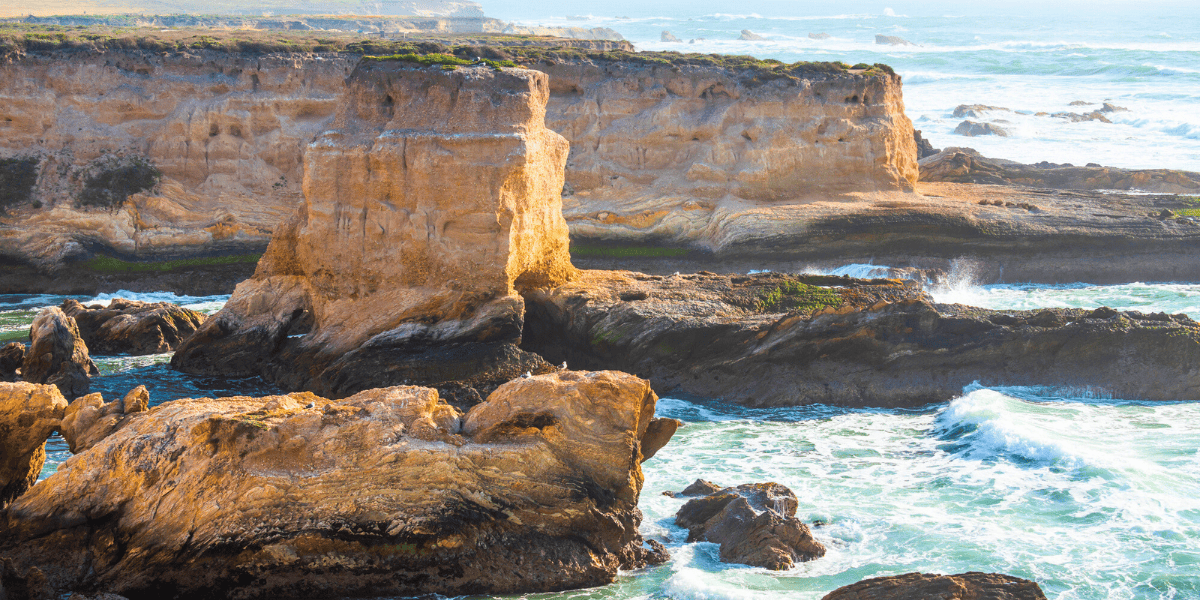EDITOR’S SUMMARY: Whether you spent your childhood building sandcastles and moats for sand crabs, or dreamed of ocean breezes from landlocked places as an adult, chances are the deep blue holds a piece of your heart. This powerful, living ecosystem—home to marine life, rich cultures, coastal communities, and countless memories—is no place for toxic waste. Discover how you can help protect what makes the sea sacred.
By Janey Bibolet Ward
A limitless and mysterious frontier, the ocean plays a crucial role in sustaining life on Earth. Beneath its surface, an astonishing array of marine creatures thrive—from iridescent mantis shrimp that can “pack a punch,” and camouflaging octopuses, to migrating dolphins and whales that traverse entire oceans. Coral reefs, often called “rainforests of the sea,” support marine biodiversity and protect coastlines. Did you know the ocean produces most of the oxygen you breathe? Tiny ocean plants called phytoplankton perform photosynthesis just like land plants, generating at least 50% of the world’s oxygen—possibly more. Despite its beauty and immense value, this mesmerizing realm remains largely unexplored, an alien world teeming with secrets. But one thing is clear: this natural wonder is suffering.

Sea Symptoms
Rising ocean temperatures and acidification due to increased atmospheric carbon are making the ocean bleed. The sea absorbs about 25% of all CO₂ emissions and captures 90% of extra heat from greenhouse gases. This phenomenon facilitates the spread of marine diseases, weakens ecosystem resilience, and reduces biodiversity. Sadly, it gets worse—according to Professor Philip Landrigan, M.D., director of the Observatory and Boston College’s Global Public Health and the Common Good Program:
“Simply put: Ocean pollution is a major global problem, it is growing, and it directly affects human health. People have heard about plastic pollution in the oceans, but that is only part of it. Research shows the oceans are being fouled by a complex stew of toxins including mercury, pesticides, industrial chemicals, petroleum wastes, agricultural runoff and manufactured chemicals embedded in plastic. These toxic materials in the ocean get into people, mainly by eating contaminated seafood.”
It’s not just people who are suffering—marine mammals and countless other creatures are being harmed, too. And as you come to understand the intelligence of marine life, it becomes clear: there’s a responsibility to protect the diverse habitats they call home. These fascinating creatures are a testament to the richness of life beneath the waves. Their advanced communication, problem-solving skills, social bonds, and self-awareness challenge you to rethink your connection to the marine world. Bottlenose dolphins, for instance, use a sophisticated system of clicks, whistles, and body language to convey information, build relationships, and coordinate group hunting. They’ve even been observed using marine sponges—soft, porous animals with skeletons made of spongin or silica—to shield their snouts while foraging along the seafloor, a clever behavior passed down through generations. Laboratory studies further confirm their capacity for memory, symbolic understanding, and remarkable imitation of human actions. Furthermore, in mirror self-recognition tests, several dolphin species demonstrated self-awareness, a trait often associated with higher cognition.
The now-famous story of the killer whale known as Tahlequah, who lost two calves and carried them in mourning for weeks after their deaths, highlights how these mammalian relatives show emotion just as humans do. Such findings underscore the depth of marine mammal intelligence and raise important ethical considerations for their conservation. In 2025, National Oceanic and Atmospheric Administration (NOAA) reported the following in “Southern Resident Killer Whale Calf Dies Days after Birth; Second Newborn Appears Healthy”:
“J35 (aka Tahlequah), who made an impression around the world in 2018 for carrying her dead calf for 17 days, is again carrying a newly dead newborn calf.”
Impact of Human Activity on Marine Life and Threats to the Oceans
Even with the ever-growing knowledge of marine factoids, the ocean remains a “final frontier” of question marks. Despite significant technological advancements, mapping the ocean remains a formidable challenge due to its expansive, largely uncharted depths. Only a small fraction of the seafloor has been explored. Another key obstacle is the “missing rivers” problem —the limited understanding of how rivers interact with ocean circulation. These powerful gyres—large systems of rotating ocean currents—act as conveyors of debris, trapping and concentrating waste into massive patches like the Great Pacific Garbage Patch. Gaining deeper insights into these connections is essential for improving ocean mapping.
Unfortunately, human society’s interactions with the sea have come at tremendous ecological costs. Massive military and commercial vessels, including fishing boats, container ships, oil tankers, and cruise liners (the largest black carbon producers), are poisoning the waters. The shipping industry has long been entangled with issues of forced labor, piracy, environmental degradation, and exposure to toxins. Similarly, one of the most pressing threats is overfishing—depleting fish populations and disrupting marine habitats. Industrial fishing practices like trawling deplete essential marine populations, disrupt delicate food chains, destroy critical habitats such as coral reefs and kelp forests, and endanger human health. Illegal fishing operations and continued whaling in countries like Japan and the Faroe Islands perpetuate both ecological and ethical abuses, raising questions about the sustainability of such cultural practices.
Plastics, chemical contaminants, oil spills, and other pollutants have taken a devastating toll. It is projected that 445.25 million metric tons of plastic will be produced in 2025 and will increase to 590 million metric tons by 2050. A significant portion ends up in the ocean, introducing microplastics that infiltrate food chains and accumulate harmful substances such as POPs (dioxins/persistent organic pollutants) and PCBs (chlorinated hydrocarbons). This pollution has led to tragic consequences, such as the death of a baby dwarf sperm whale after ingesting a large plastic bag, which starkly demonstrates the pervasive damage and suffering caused by these contaminants. Similarly, autopsies of marine life often reveal carcasses full of plastic waste.
Single-use plastics dominate global waste streams, overwhelming recycling systems and contributing to a growing environmental burden. Microplastics (particles smaller than 5 millimeters) are especially insidious. They enter the environment both intentionally (e.g., microbeads, synthetic fibers) and unintentionally (via the breakdown of larger plastics like abandoned fishing gear). Once dispersed, these particles are ingested by marine organisms, causing physical harm, chemical contamination, and cascading disruptions throughout food webs. Human consumption of microplastics has recently been associated with disease and has been found in people’s brain tissues.
Besides plastics, humans contribute to a cascade of other aquatic problems, like algae blooms. The term is deceptive, as algae bloom (the result of excess nutrients from wastewater, fertilizer, and stormwater runoff) is not nearly as pleasant or benign as it sounds. When pesticides or other toxins enter water sources, including rivers and oceans, algae can go crazy when particular weather conditions exist. And this can lead to a host of health problems for everyone from pets and humans to fish and other sea creatures.

Circular Solutions
Humans aren’t the only ones harming the oceans and its inhabitants. One threat to marine life comes from a very unusual and unexpected source: birds. Thanks in part to landfills offering an abundance of scavenging opportunities, the bird population has exploded, and they’re celebrating by taking it out on marine mammals. Seagull attacks on mother whales, for instance, began increasing in the 1990s. Such attacks led whales to change their surfacing behavior, exposing their blowholes to protect themselves. Recently, gulls have shifted to attacking calves instead, causing them to suffer painful deaths from multiple bites. It has been observed along the migratory path in Argentina that the whale population is dwindling significantly, threatening the species’ survival.
Thankfully, modern waste management strategies offer promising solutions. Municipal solid waste (MSW) challenges—from groundwater contamination to safety hazards—are being addressed through advanced energy recovery methods. Methane capture from landfills transforms waste into energy, reducing greenhouse gas emissions while powering homes and businesses. Denmark serves as a leading example of cutting-edge waste management with its waste-to-energy plants, which convert refuse into renewable power, decrease landfill dependency, and also serve as an urban recreational facility. Transitioning to a circular economy, where plastics are continuously recycled into high-quality products, can reduce reliance on virgin resources. Alternatives such as bioplastics offer a potential solution, but their widespread adoption requires systemic change. These shifts may not keep plastics out of oceans at as high of a level as preferred, true. But innovations in recycling, upcycling, and the development of sustainable products are critical to addressing the plastic waste crisis.
There is another human-caused ocean sickness: disasters like oil spills, large-scale fires, and nuclear incidents gone wrong (e.g., Fukushima in 2011). How is Pacific sea life supposed to recover from significant amounts of radioactive material hurled into its waters in Japan? And who can forget the images and videos of ducks and other water creatures slick with Exxon oil in 1989? These global environmental challenges have profound implications for marine life worldwide. Zeroing in on California: Recent wildfires in areas like Malibu and Pacific Palisades in Los Angeles have raised concerns about their impact on coastal creatures. While scientists are still unraveling the full extent of the damage, early findings suggest the effects are far from positive, with potential disruptions to the ecosphere already stressed by other environmental factors.

Looking Ahead: Initiatives and Solutions
Naturally, the vastness of the ocean and its creatures permeate nearly every facet of human society, including politics. Geopolitical barriers hinder progress in securing international agreements, like the proposed Global Plastics Treaty, which aims to establish specific design mandates that would eventually lead to a significant reduction in plastics consumption. Challenges remain in enforcement, accountability for shared cleanup costs, and addressing the true social and ecological costs of plastic production across the globe. Despite the formidable obstacles, a path forward exists. Global collaboration, innovative technology, and sustainable practices can drive meaningful change. Tools like the Ocean Health Index (OHI) offer comprehensive assessments of marine networks. International initiatives to reduce greenhouse gas emissions and implement sustainable fishing practices are vital steps. Strengthening regulations and enforcement across industries is similarly vital.
Key initiatives include The Ocean Cleanup project, which removes plastic from the Great Pacific Garbage Patch, and NOAA, conducting research and developing policies for marine protection. Organizations like the Surfrider Foundation promote beach cleanups and plastic reduction policies. Legislative efforts such as the 2021 Plastic Pollution Reduction Act (PPRA) and the 2018 Save Our Seas Act (SOS) aim to curb plastic waste. Restoration projects focus on rehabilitating critical habitats such as coral reefs, mangroves, and seagrass beds. While progress is being made, sustained action is necessary to address this environmental crisis. Addressing these issues requires a unified global effort; no single country can solve them alone. Individual nations can assist by pioneering groundbreaking policies, advancing marine technology, and fostering international cooperation. As awareness grows, so do efforts to curb plastic waste, regulate fishing practices, and restore the marine biosphere. With a stronger commitment to ocean conservation, working together toward a future where the seas remain a thriving sanctuary for life on Earth is possible.
How to help: By adopting simple daily habits and establishing healthier routines, you can make a powerful impact on protecting the oceans for future generations. Here are a handful of effective steps:
- Choose reusable bags, bottles, and containers over disposable options.
- Clean and sort recyclables according to local guidelines to enhance recycling efficiency.
- Opt for items made from recycled or recyclable materials to encourage environmentally-friendly production practices.
- Choose nontoxic cleaning products.
- Reduce (or eradicate) your use of pesticides and herbicides.
- Dispose of motor oils and other similar liquids properly.
- Resist the urge to flush medication down the toilet; instead, opt for local disposal options offered by cities and hospitals.
- Eat sustainable seafood (e.g., Alaskan salmon/halibut, mackerel, and sardines).
- Promote responsible aquaculture (farming of aquatic organisms) locally.
The sea is facing unprecedented difficulties, but its potential for transformation is just as powerful. Progressive research, bold actions, and growing international collaboration are starting to shift the tide. From grassroots movements to corporate responsibility, momentum for change is building—yet time is running out. Swift, decisive action is essential to ensure a future where the ocean thrives. The complexity of these challenges demands a unified approach. Addressing them requires advanced technology, forward-thinking policies, and a collective commitment to sustainability. By rethinking your habits and embracing eco-conscious practices, you can play a crucial role in safeguarding both human communities and the aquatic world. Through cooperation and creative solutions, a cleaner, healthier, and more resilient future is within reach.
~
Published on April 10, 2025.
If you’ve found value in this article, please share it!
To support the research and health education of AVFC editorial, please consider making a donation today. Thank you.

